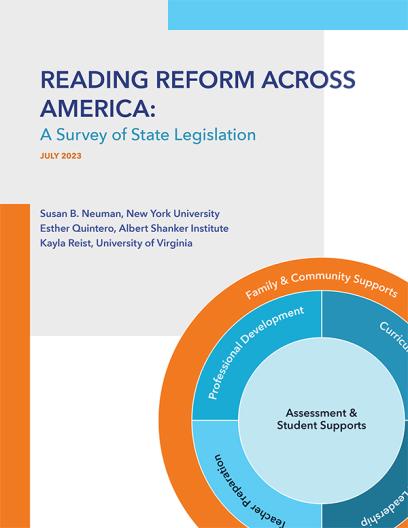Despite the science of reading being clear—and despite decades of the AFT sharing that science—for too long, many state and local policies on reading instruction have promoted less-effective practices.
During the workshop “Literacy for Leaders: What Locals Can Do to Support Student Literacy” at AFT TEACH, a state union leader and the Albert Shanker Institute presented research on teaching reading and a new Shanker Institute analysis of recent state laws on literacy.
Mary Cathryn Ricker, a National Board-Certified Teacher and ASI’s executive director, said the institute wanted to get a tool into the hands of the teachers, paraprofessionals and families closest to reading instruction. She noted that local unions are in the powerful position of bargaining for the common good.
The survey of state legislation between 2019 and 2022 aims to analyze the unprecedented wave of reading legislation nationwide; to engage educators, scholars and families in discussing reforms; and to support an accurate framing of reading reforms. “We wanted to get to the truth,” Ricker said.
The institute looked at how reading instruction supports educators, students, families and communities in over 200 bills enacted in 45 states and Washington, D.C.
In a nutshell, ASI found that the bills are not dominated by phonics instruction; in fact, most states give equal weight to the five pillars of reading set by the National Reading Panel: phonemic awareness, phonics, vocabulary, fluency and comprehension.
The Shanker Institute also found that the legislation touches more schools than previous literacy efforts—and that elected officials across the political spectrum are showing leadership. The analysis uncovered bipartisan support for legislation in more progressive states like Connecticut and Michigan but also in more conservative states like Florida and Utah.
Even with this progress, there’s plenty of room to grow. Oral language and writing receive less attention in most legislation. Assessment, as always, is prioritized. And the new laws pay uneven attention to student groups—for example, lavishing attention on students with dyslexia and shortchanging English language learners. Another common bug is inadequate attention paid to instructional supports. And the key to all of it is implementation, with more emphasis on alignment and coherence.
For example, Texas now requires 100-200 hours of training for all teachers. But without compensation (except for a few districts with small stipends), teachers have cited this unfunded mandate as a reason for leaving the profession.
Colleen Callahan, director of professional issues for the Rhode Island Federation of Teachers and Health Professionals, shared the journey of her state through passage of and revisions to her state’s Right to Read legislation. The 2019 law focuses on educator proficiency and awareness, charging the state education department with setting criteria.
Callahan said there’s agreement in principle that greater pre-service preparation and professional development in literacy are needed. That said, the state has often set unrealistic, burdensome requirements and lacked recognition for educators’ experience.
She credited the AFT with helping craft Rhode Island’s professional development coursework and with successfully lobbying for improvements to the original legislation. Through the AFT Innovation Fund, the state federation was able to train trainers across seven local affiliates in how to implement the law.
In a question-and-answer exchange, Albuquerque Teachers Federation President Ellen Bernstein said she’s concerned about the narrowness of the reading conversation nationally—that it ignores the larger context of reading, writing, speaking and listening. But in all, the presenters are heartened to see states starting to support evidence-based reading instruction.
[Annette Licitra/Suzannah Hoover photo]


